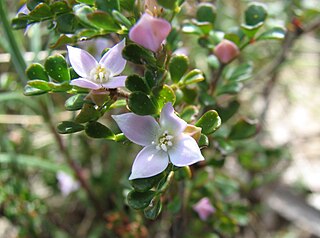
Boronia algida, commonly known as alpine boronia, is a flowering plant in the citrus family, Rutaceae and is endemic to south-eastern Australia. It is an erect shrub with many branches, pinnate leaves and white to bright pink, four-petalled flowers usually borne singly on the ends of branches.

Cyanothamnus baeckeaceus is a plant in the citrus family, Rutaceae and is endemic to eastern Australia. It is a slender or straggling shrub with simple or trifoliate leaves and pink and white four-petalled flowers. It is endemic to the south-west of Western Australia.

Boronia barkeriana, commonly known as Barker's boronia, is a plant in the citrus family, Rutaceae and is endemic to eastern Australia. It is a shrub with ground-hugging branches, simple, toothed leaves and bright pink, four-petalled flowers.
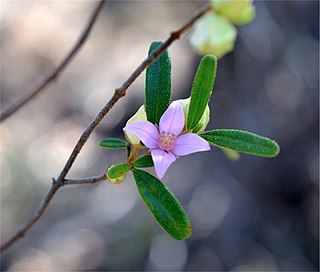
Boronia duiganiae is a plant in the citrus family Rutaceae and is endemic to mountain ranges in south-east Queensland, Australia. It is an erect shrub with many branches, leaves with one, three or five leaflets, and pink to white, four-petalled flowers.

Boronia filifolia, commonly known as the slender boronia, is a plant in the citrus family Rutaceae and is endemic to south-eastern Australia. It is a slender shrub with simple or pinnate leaves and pale to deep pink four-petalled flowers.

Boronia forsteri is a plant in the citrus family Rutaceae and is endemic to mountain ranges in central Queensland, Australia. It is an erect shrub with many branches, simple leaves with a densely hairy, pale underside, and pink, four-petalled flowers.

Boronia glabra, commonly known as sandstone boronia, is a plant in the citrus family Rutaceae and is endemic to eastern Australia. It is an erect or weak shrub with many branches, mostly glabrous leaves with a slightly paler underside, and bright pink, four-petalled flowers arranged singly in leaf axils.

Boronia grandisepala is a plant in the citrus family Rutaceae and is endemic to northern parts of the Northern Territory. It is an erect shrub with elliptic leaves and white, pink or burgundy-coloured, four-petalled flowers.

Boronia odorata is a plant in the citrus family Rutaceae and is endemic to the central highlands of Queensland, Australia. It is an erect shrub with many branches, mostly simple leaves and pink to white, four-petalled flowers.
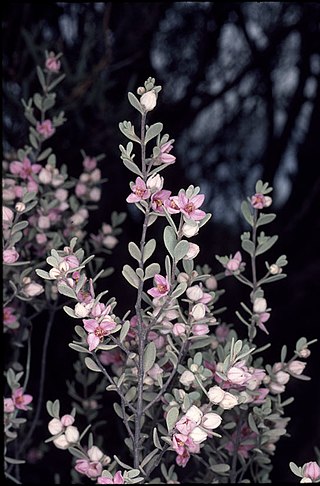
Boronia ternata is a plant in the citrus family Rutaceae and is endemic to the south-west of Western Australia. It is an erect shrub with many branches, simple or trifoliate leaves and white to pink four-petalled flowers.

Boronia bella is a plant in the citrus family Rutaceae and is endemic to a mountain range near Many Peaks Queensland, Australia. It is an erect shrub with many branches, simple leaves and four-petalled flowers.
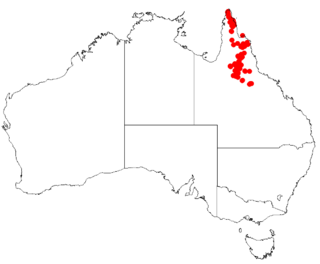
Boronia bowmanii is a plant in the citrus family, Rutaceae and is endemic to Queensland. It is an erect shrub with pinnate leaves and four-petalled flowers.

Boronia jensziae, commonly known as Andy Jensz's boronia or Hinchinbrook boronia, is a plant in the citrus family Rutaceae and is endemic to Hinchinbrook Island in Queensland. It is an erect, densely branched shrub with simple leaves and pink to white, four-petalled flowers usually arranged singly in leaf axils.

Boronia quinkanensis is a species of plant in the citrus family Rutaceae and is endemic to a small part of Queensland, Australia. It is an erect shrub with most parts covered with star-like hairs and has pinnate leaves with up to eleven leaflets, and pink to white, four-petalled flowers.
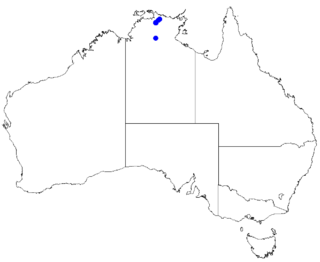
Boronia rupicola is a species of plant in the citrus family Rutaceae and is endemic to a small area in the Northern Territory, Australia. It is a small shrub with weeping branches, simple or pinnate leaves and small, green, inconspicuous flowers.

Boronia splendida is a species of plant in the citrus family, Rutaceae, and is endemic to Queensland, Australia. It is an erect shrub with most parts covered with star-like hairs and has simple, linear to narrow elliptic leaves, and pink to white, four-petalled flowers.

Boronia squamipetala is a species of plant in the citrus family, Rutaceae, and is endemic to Queensland, Australia. It is an erect shrub with pinnate leaves with between five and thirteen elliptic leaflets, and green to white, four-petalled flowers with hairy backs.
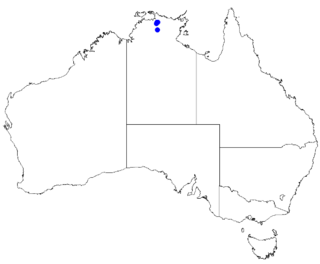
Boronia suberosa is a species of plant in the citrus family Rutaceae and is endemic to a small area in the Northern Territory, Australia. It is a shrub with weeping branches, simple leaves, and flowers with four small, white petals.

Boronia tolerans is a plant in the citrus family, Rutaceae and is endemic to a small area in the Northern Territory in Australia. It is an erect shrub with many branches, pinnate leaves and white, four-petalled flowers. It is only known from Nitmiluk National Park.

Boronia verecunda is a species of small, erect shrub that is endemic to a small area in the Northern Territory. The flowers are borne singly in leaf axils and are white or pink but turn green as the fruit matures. It is similar to B. xanthastrum.





















